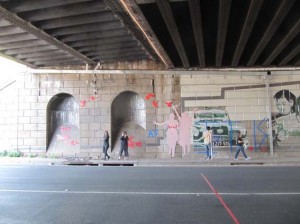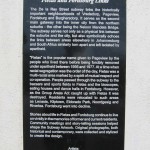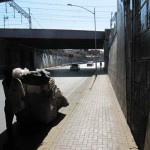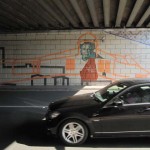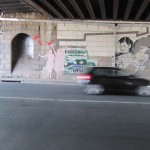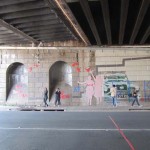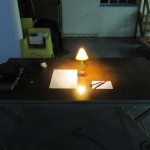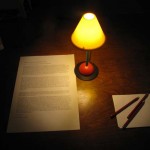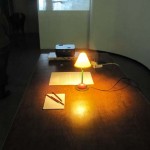JHB / Third day / Under a bridge
Titre / Title : Under a bridge / Sous un pont
Auteurs / Authors : Tao Skosana,Victoria Vigzell, Thuso Moruthane, JC Lanquetin…
Description : A graphic intervention via colored tapes on a fresco under a bridge between Fordsburg and Fieras. The fresco is the result of a community project recalling the human connections during the Apartheid time between the two areas. We decide to intervene directly on the fresco via colored tapes, in order to question the way this story is staged.
Axes de recherche / Research axes (Play/Urban) : Public space > Art in public sphere.
>>>>>>>>>>>>>>>>>>>>>>>>>>>
In situ
medium : collective intervention via graphic intervention on a wall.
genre :
concept : Public intervention in urban space. Is it a performance, an event, an intervention ?
participants : Tao…, Megane Mace, Victoria Vigzell, Jc Lanquetin
durée / duration :15-20 min
ville / city : Johannesburg – between Fordsburg and Fieras areas
Questions : What is public space today in Johannesburg ? What is the point of view of younger generations on the narratives which are today becoming the “official story” of the time of the Apartheid ? What about the possibility of intervening on public space art pieces (an more generally in public space), and interrogate them ? And if intervention there is, what form can it take ? When does it become a destruction ? (in our case, the debate is around the choice we did to intervene via tape and not via painting or tag – in order to clearly signify it’s not a destruction). The reactions to this project, especially from the people who did it and considered the intervention was a destruction, suggests that there is a possible polemic debate on this.
>>>>>>>>>>>>>>>>>>>>>>>>>>>
Exhibit
medium : fresco in situ & little installation during an exhibition P>U 2012 at King Kong building.
genre :
concept : question
participants : Jc Lanquetin
durée / duration : Until it was removed
ville / city : Johannesburg, under the bridge between Fordsburg and Fieras.
date : Sept 2011 & sept 2012.
Questions : Exhibiting the intervention is probably a way to take people to the point, via a proper installation related to the intervention. But at the same time, an aspect of the point can be considered as missing in the all process, as only a few people, mostly in link with the art sphere, came to see the exhibition.
>>>>>>>>>>>>>>>>>>>>>>>>>>>
Analyse critique / Critical analysis : The intention was to question a narrative, the way this “positive” story from the Apartheid time is formulated, (re)staged, reframed for the present time. About this intervention, an important question is : what was it’s real impact ? According to the reactions, it was mostly perceived as a deterioration of the original fresco (see text below). It was supposed to be addressed to the people passing by under the bridge. We have no idea of what they received from it. But at the same time, is it important ? When it is about audiences, it’s a constant dilemma. Do we have to be extremely visible, be shure in a way or another a lot of people will see it ? Or at the reverse (to make it simple), the almost secret character of an intervention is meaningful in itself.
Also, the time to develop the project was short and very probably the intervention were not sharp and precise enough.
The question is a bit different for the later exhibition : this experience seem to question interesting and actual issues related to the perception of Apartheid time according to generations. The “official” reaction can be perceived as a censorship as it doesn’t take into consideration the fact it was a response to the fresco. A attempt for a dialog. So, the all process and the documents related to it, are an interesting material for an installation.
>>>>>>>>>>>>>>>>>>>>>>>>>>>
Protocoles (collectif) d’action / (collective) action protocole : Each member of the group has colored tape and via drawing, text, asks questions directly on the fresco. Some others members of Play>Urban join the intervention.
>>>>>>>>>>>>>>>>>>>>>>>>>>
A TEXT BY JEAN CHRISTOPHE LANQUETIN
A project under a bridge, between Fordsburg and Fietas.
A one day experimentation, the second day was about a presentation, in context. One area for each group, in the inner city Johannesburg. We directly go to this road under the railway bridge, between two areas, Fordsburg and Fietas. On the walls, a fresco about the apartheid time and the solidarity between people from different areas and origins in this racial context. The fresco is the result of a collaborative project, by urban activists in link with inhabitants. We see it as esthetically not bad, but really naive. Most of the young students are in their twenties ; they are born at the end of the apartheid time, and they didn’t experience this directly in their life, they were not part of the fights ; they are the new generation and it seems the connexion between this new generation and elders, about the past, is a new challenge. In my group they are 4, and the discussion comes about the fact they respect this past but they feel it becomes for them as an impossibility to affirm their own vision of life, their own space. They explain, everytime they want to do things their own way, there is an elder who says its in contradiction with the fights of the past. We have a long and intense discussion about the fact they feel trapped by this situation.
Our collective project becomes about this, by intervening on the fresco as a way to give contradictory, and more multiple point of view, also about the present time, directly on it. We consider it as a right, as a way to « continue » the process, also because we are in public space. The idea is to continue but not destroy it, which would be the case if we would tag or paint it (which is already the case, there is some small comments and one or two tags, but not so much – the fresco seems quite respected), etc. That’s why we decide to intervene with colored tape. After long discussions we come to the point the next day, during the restitution, we will come with others members of the P/U project, and write our point of view. I decide to write a sentence I heard from workers, carrying rubbishes and cardboard on trolleys under the bridge. I saw many of them during the time we spent there, and when we asked a few of them what they think about the fresco, they said something like : I DON’T HAVE A CHANCE FOR THAT. But we agree on the fact each of the persons who is intervening writes something different, and personal (I also question with a « ? » this word « SISTERS », as I see it as very reductive about the reality of the past, which becomes like a kind of fairy tale. The next day we do it, it takes 15mn, and then we leave. For us the audience is the people who assist this « performative » moment, but mainly people who drive or walk under the bridge.
We think the project is finished, in fact, it begins. There is reactions. Someone who participated the initial process, sees the taped texts and drawings and recognizes the Wits School of Art and the people (us) who made it. He sends a letter (as i understood), to the WSOA direction, complaining and asking the school to pay for the « restoration » of fresco. The school does it. A few months after, one evening, during a conversation, I discover the person who made the restoration is a friend, and is also the person who realized the initial project (paintings, drawings…). We have a long and very interesting conversation about the project (she didn’t know who made it). At the beginning she is upset about the people (us) who tagged the wall with tapes. I explain the all story, I speak about the discussion we had, the students and I, and insist on the fact we worked with tapes, not with painting. But it seems the tapes were too strong and partly destroyed the paintings. And most of all, she says, our intervention gave other people the feeling they can tag the wall. Especially one drawing by one of us, tits on a woman’s body. Of course it’s not the best idea, but the all thing is about freedom in public space. With B, during our conversation, we are in Doornfontein, in front of a gallery and the opening is taking place in the street. Next to us there is metallic sculptures, and she asks : « would you intervene on this ? » I say, yes, if I had a reason. She doesn’t agree…. I continue : « personnally I would find a way not to destroy, but to question, to dialog, same kind of dispositif as we did with the tape, but i can understand, in principle someone would do differently… as we are in a public space ». Long conversation, very interesting as it questions this notion public space, in the context of a city like Johannesburg. And how, seen from my eyes, these kind of interventions as part of a re-gentrification process, are becoming a bit sacred.
> find texts, articles about public space and public art in Joburg
During the first Play>Urban exhibition in 2012 at VANSA (Johannesburg), a table, a text, and a screening about the “under the bridge event” in 2011. We’ve asked for the official letters sent to the Wits, and the responses, but we didn’t get them.
Re-reflections on the intervention under the bridge between Fordsburg and Fietas, 2011, Victoria Wigzell
The actual act, or event of taping phrases and images onto the walls of a public art work only lasted about 15 minutes. It was the culmination of a 2 day process of exploration and interrogation within the areas of Newtown and Fordsburg, Johannesburg. The larger group of participants within the Urban Games programme had split up into several smaller groups, and each had been been stationed at various different points within the area of Greater Johannesburg. Our group had been stationed in Fordsburg, an area characterised by the large Indian population living there. After roughly one day of walking, pointing out and discussing potential areas of interest, one of our colleagues suggested we visit a site under the bridge between the areas of Fordsburg and Fietas. The bridge and the area underneath it is not only an arbitrary marker between geographical areas within the city, but it is also a throughfare used by people moving to or from work and gaining access to various different transport networks. What interested us most about this space was the fact that it is also the location of a public artwork which speaks of the history of Fietas before its ‘dismantling’ as a result of the Apartheid regime’s Group Areas Act. Fietas has been described as a small, yet vibrant ‘multiracial’ area, which was partially demolished during the 1970′s. The different non-white racial groups living there were reloacted to designated areas on the outskirts of the city.
The artwork- which was intended to commemorate and celebrate Feitas- runs across the entire length of the walls underneath the bridge and uses coloured metal and paint to describe life in the area before its demolition. It was created by the Trinity Session- a public art production company which works in close conjunction with the City of Johannesburg for the creation of public artworks within the city. Our interaction with this space sparked a number of questions associated with the relevance of institutionalised public art; its intended roles and its connection or disconnection with environments and populations which surround it. We knew that we wanted to intervene, but were initially uncertain on how we should do this. Do we blast our opinions all over the wall? And if we were to do this would we be provoking any kind of discussion or meaningful interaction from the people who encounter it? We decided to ask people moving through the space {essentially on their way to other places} what their opinions of the artwork were, and to then transmit these responses onto the wall using coloured tape. The tape {we thought} would be temporary, and would not be construed as vandalism, or promote the vandalism of the artwork. The intervention would take place as part of the presentation day where each group would present the results of their interactions with the areas in which they were stationed. Particpants would be given a role of coloured tape and a sentence to transmit onto the wall.
Our action had a large reaction, not from people living in the area but from the Trinity Session- the original creators of the work. A phrase taped onto the wall indicated that the intervention had been carried out by students fron Wits university, and the school was implicated and held responsible for damage done by the glue of the coloured tape on the artwork. The intervention also did not spark any debate between the creators and ourselves on the relevance of the artwork itself as well as our activity, but was construed more immediately as an act of vandalism. This occured because the intervention was not controlled, participants were not stopped when they had finished taping the sentences and started taping random words, shapes, and boobs onto the walls. Essentially we had too much tape, and not enough sentences, and had not thought of how to direct particpants on how to engage with the intervention. This sparked again for us more questions: were we wrong to have allowed participants to say what they wanted on the walls? Would the act still have been seen as vandalism if what was taped onto the wall had been strictly responses to the work itself? And if in that case in what way would our intervention have been useful? Ultimately the intervention left us with more questions than answers, but we were sure if anything like this was to be done again, we would be more careful to hide our identities next time.

